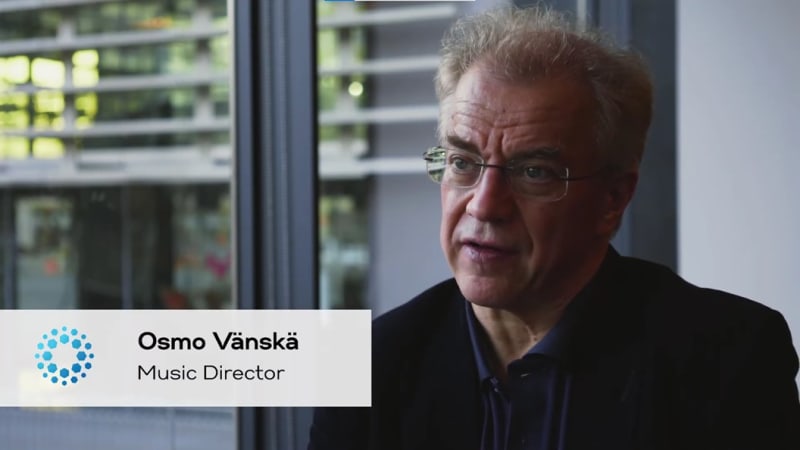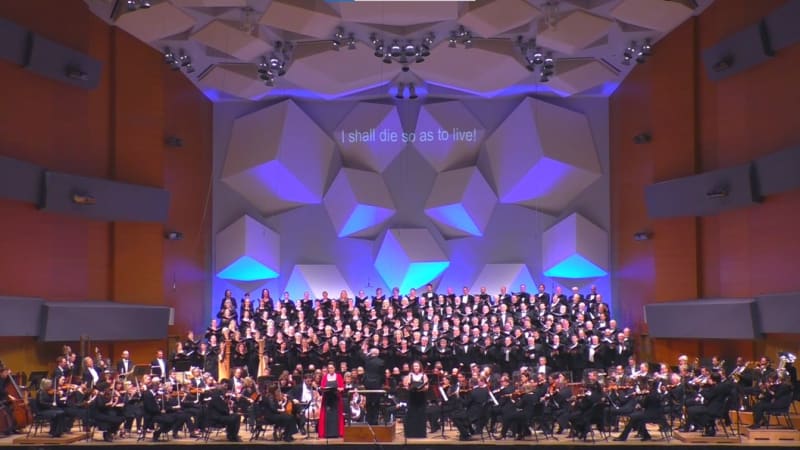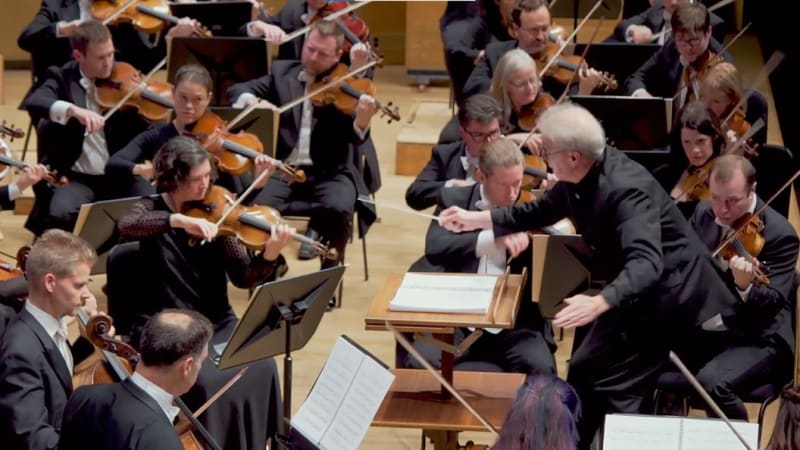The Mahler Project: A Look Back

By the numbers, Osmo Vänskä’s many recording achievements with the Minnesota Orchestra as of the end of this month could almost be sung to the tune of “The Twelve Days of Christmas”: 90 days of recording, 27 symphonies, 21 CDs released, seven piano concertos, four Grammy nominations and a Grammy Award for Best Orchestral Performance.
The Orchestra has been recording a wide range of music for two years shy of a century, but only Vänskä has led the Orchestra in what is widely considered the most ambitious of orchestral recording projects outside of the opera genre: a recording of all the symphonies by a single composer, known as a symphony cycle. He has done it at Orchestra Hall not once but three times in collaboration with BIS Records.
Vänskä’s first recording project with the Orchestra, the nine Beethoven symphonies, was hailed by Gramophone magazine as “one of the finest available Beethoven symphony cycles.” The Jean Sibelius symphonies recorded in the midpoint of his music director tenure won the Orchestra its first Grammy Award for Best Orchestral Performance in 2014. His capstone recording initiative with the Orchestra—a cycle of Gustav Mahler’s ten epic symphonies—concludes this month when he returns to Orchestra Hall for the first time as conductor laureate to perform and record the Romantic-era composer’s Third Symphony.
As the monumental Mahler project draws to a close, we look back at performance videos, interviews, reviews and more, in the order the symphonies were recorded.
Want to catch the finale of this mega Mahler project? This weekend, the Minnesota Orchestra welcomes Conductor Laureate Osmo Vänskä back to finish what they started with Mahler's Third Symphony.
Symphony No. 5
Mahler’s Fifth was the first symphony to be recorded, in June 2016, and the album earned a 2018 Grammy nomination for Best Orchestral Performance. Gramophone magazine interviewed Vänskä about the symphony and the recording in August 2017.

Symphony No. 6
The Orchestra recorded the Symphony No. 6 in November 2016. Most famous for its unique percussion part that calls for blows from an oversized hammer to represent fate, the symphony was described by Vänskä as being like cooking: Mahler adds more and more elements to the proverbial soup until it all boils over.
Symphony No. 2
“I shall die so as to live,” sings the choir in German in the unforgettable finale of Mahler’s Second Symphony, the Resurrection Symphony, which was performed and recorded by the Orchestra, Minnesota Chorale, soprano Linh Kauffman and mezzo Adriana Zabala in June 2017.
Symphony No. 1
Under the direction of its fourth music director Dimitri Mitropoulos, the Minnesota Orchestra—known at the time as the Minneapolis Symphony Orchestra—was the first orchestra ever to record Mahler’s First Symphony, sometimes known as the Titan Symphony, in 1940. The Orchestra revisited the symphony 78 years later under Vänskä’s baton in March 2018. In a review of the CD, John J. Puccio stated that “The Minnesota Orchestra acquit[s] themselves wonderfully, producing a big, rich, radiant, and highly disciplined sound…there is much beauty in [Vänskä’s] performance, a beauty often overlooked by other conductors in favor of Mahler’s more histrionic qualities.”

Symphony No. 4
The next symphony to be recorded was the Symphony No. 4 in June 2018, with soprano Carolyn Sampson joining the Minnesota Orchestra as soloist in the final movement. The Fourth is the shortest and lightest in instrumentation of Mahler’s symphonies—although short is a relative term in comparison with the other symphony cycles Vänskä has recorded here; spanning 59 minutes on the Orchestra’s album, it is longer than any Sibelius symphony and all but one of Beethoven’s. Following is an excerpt from the performance that preceded the recording sessions.
Symphony No. 7
The Symphony No. 7—an epic voyage from night to day—sustains an intensity of expression across five virtuoso movements. The grandiose finale is a stunning daybreak, delivering a rush of incandescent energy and overflowing with melodic ideas. Vänskä and the Orchestra recorded it in November 2018; view an excerpt from the concert performance below.
Symphony No. 10
The Orchestra’s final recording sessions before the COVID-19 pandemic, held in June 2019, featured Mahler’s Symphony No. 10. The Tenth holds a controversial position in the Mahler canon as it was unfinished at the time of the composer’s death, and some Mahler symphony cycles exclude it entirely or capture only the first movement. The Orchestra recorded it in the performing version completed by Deryck Cooke. Brian Newhouse, former host of the Orchestra’s broadcasts on YourClassical Minnesota Public Radio and now the Orchestra’s associate vice president of individual giving, spoke with Vänskä about the symphony, masked and distanced in Orchestra Hall’s Kathy and Charlie Cunningham Green Room early in the pandemic.
Symphony No. 9
After nearly three years of pandemic-induced hiatus, the Orchestra and Vänskä returned to recording in March 2022 with Mahler’s Ninth Symphony. In a review of the performance that preceded the recording sessions, the Star Tribune’s Rob Hubbard declared that the symphony’s finale was “a powerful showcase for the lush, layered string sound this orchestra can produce” and noted that at the symphony’s conclusion, “the Orchestra Hall audience sat in rapt silence for what seemed almost a minute before erupting into a lengthy ovation.”

Symphony No. 8
The Eighth Symphony, known as the Symphony of a Thousand—much to Mahler’s chagrin—was the final work performed and recorded by Vänskä before the end of his 19-year music director tenure, with seven vocal soloists and the Minnesota Chorale, National Lutheran Choir, Minnesota Boychoir and Angelica Cantanti Youth Choirs joining the Orchestra for performances and recording sessions in June 2022.
Symphony No. 3
The initial plan for Vänskä to record all ten Mahler symphonies with the Orchestra during his music director tenure had its schedule shuffled by the COVID-19 pandemic, so one symphony was still left when he completed his tenure and became conductor laureate this fall. However, it wouldn’t be very Finnish of him to leave a project unfinished, so Vänskä is returning from November 10 to 12, 2022, for three performances of Mahler’s Third Symphony with mezzo Jennifer Johnston, the women of the Minnesota Chorale and the Minnesota Boychoir that will be followed the next week with recording sessions.
Tickets are still available for the November 10-12 concerts—don’t miss the historic close of the Minnesota Orchestra-Osmo Vänskä Mahler project! Looking for gift ideas or want to add Mahler symphony recordings to your collection? Visit our online shop.
Related Articles

Inside the Music
Super Composer
Conductor Sarah Hicks shares why John Williams’ film music touches us so deeply

Inside the Music
What is the Sheng?

Inside the Music
Program Notes: The Exterminating Angel Symphony

Inside the Music
Leila Josefowicz: Bridging Generations

Inside the Music





